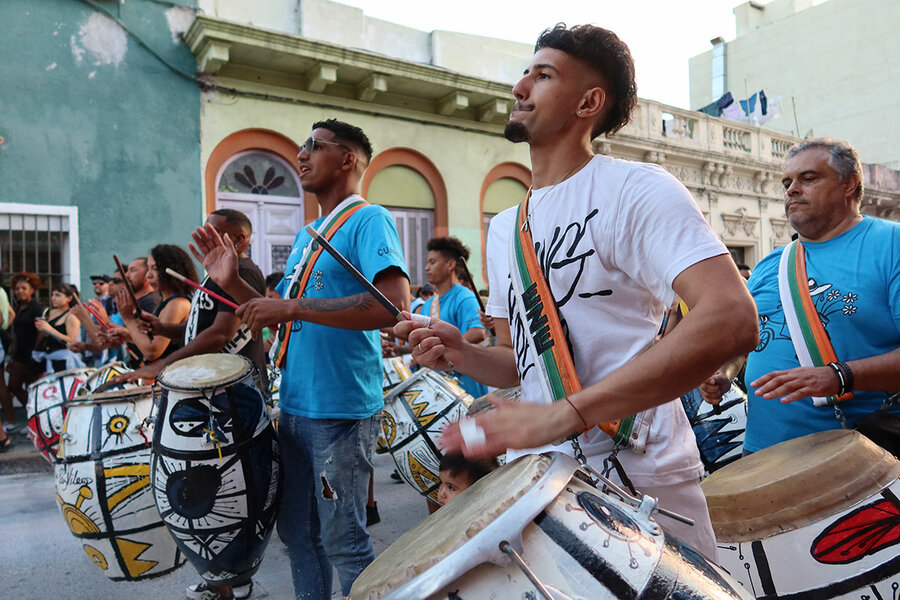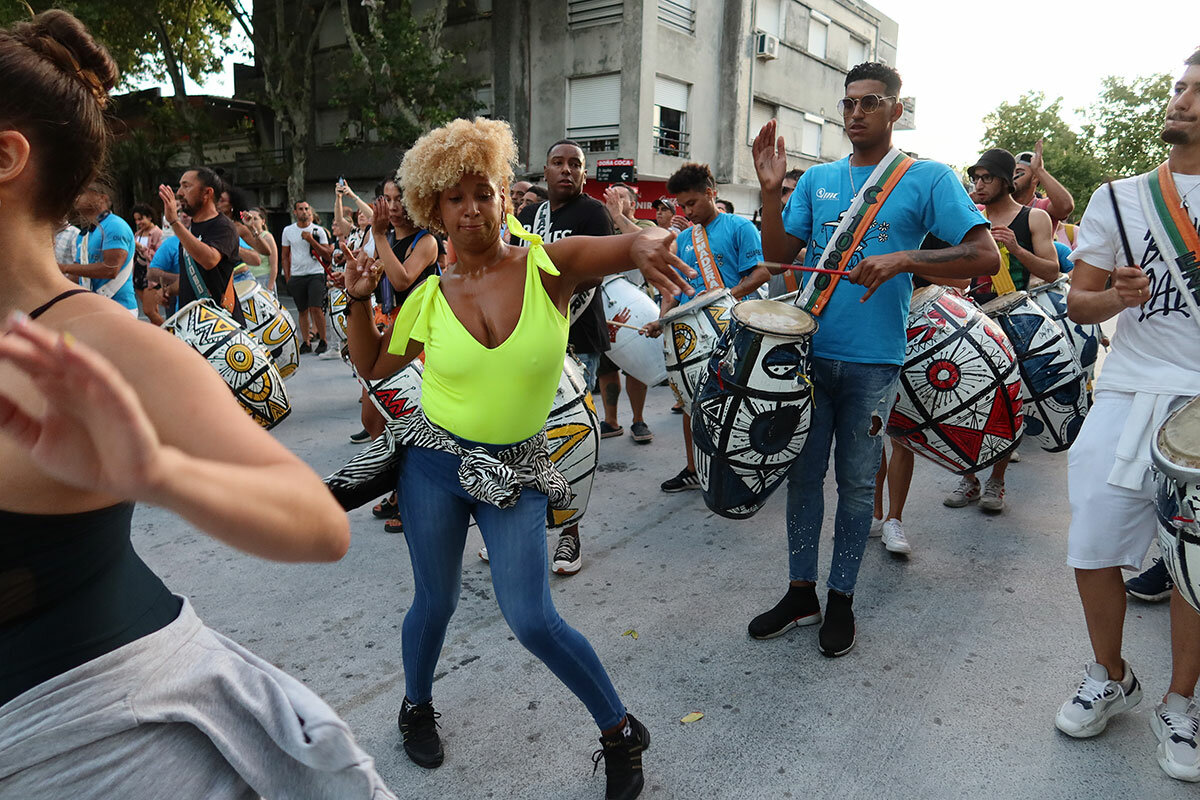Finding joy among strangers: The Afro-Uruguayan rhythm that embraces all
Loading...
| Montevideo, Uruguay
One by one, the drums unite from every direction. Slung over shoulders, cradled by old-timers, and clasped on either side by children, they meet on a corner in the Montevideo neighborhood of Barrio Sur.
The pulse begins sporadically, an unorchestrated call to gather. Those perched on curbs and leaning against cars perk up and wander over. By the time the Uruguayan flag takes to the air, waving from one side of the street to the other in the hands of a proud bearer, the drums are thumping in perfect unison. Dancers give life to the beat as they lead the parade down the block.
This is candombe, a distinctly Uruguayan rhythm brought into being by the descendants of enslaved Africans who arrived at the port of Montevideo in the 18th century. Today that lineage is celebrated loudly and triumphantly, with this event marking the end of the Carnaval season. Wherever candombe goes, it makes visible a culture long left out of mainstream Uruguayan society.
Why We Wrote This
A story focused onAn Afro-Uruguayan rhythm may be traced back to slavery, but it’s transcending present-day divisions and differences to spark joy across Uruguay.
In the past few years, interest in candombe has boomed both within Uruguay and abroad. While some worry popularity could water down the tradition’s richness, those in the community say this beat belongs to everyone, and all are invited to make it their own.
“For us, it doesn’t matter your ethnicity, your skin tone, your age, your gender, if you have three university degrees, or if you never finished high school,” says Wellington Silva, who has led this troop, one of the city’s most revered, alongside his brother since their father passed away. “The drums bring joy, they open channels of communication, they turn us into brothers and sisters.”
As the sun dips out of sight, the division between procession and observers fades. Dancers, shy at the start, now twist their hips and kick out their feet as children weave in and out of the crowd making its way down the iconic Isla de Flores street. Neighbors sway from balconies and rooftops where Saturday laundry is hanging to dry. Leaders in the community say that’s the beauty of candombe.
“Anyone who happens to pass by is bound to hear and to want to know more,” says Álvaro Salas, the director of culture at the nonprofit Mundo Afro, which focuses on the visibility and rights of the Afro-Uruguayan population. “That’s the most natural part of being human. We have to love joy.”
There are three main styles of candombe in Montevideo: Cuareim, Ansina, and Cordón. The candombe troop marching today, Cuareim 1080, was born on this very block, named after the historic address of the building where the parade convenes. Now an apartment complex, the seemingly nondescript building used to be a tenement where the city’s poor lived, including Mr. Silva’s father.
The practice of candombe had faded in the late 19th and early 20th centuries but found a new home in these communal living spaces. In the late 1970s, this and other conventillos, as the tenements were known, were cleared by the military dictatorship in an effort to make the center of Montevideo more attractive.
“They pick you up and throw you out, and what happens? You expand,” says Dr. Salas. “Today, there is candombe in every neighborhood in Uruguay.” Through Mundo Afro, he teaches candombe to kids, leads workshops in prisons, and is working on a candombe partnership between Montevideo and Minneapolis as appreciation for the culture spreads.
Afro-Uruguayans make up around 10% of the Uruguayan population and are three times as likely to live in poverty as white Uruguayans. But members of the candombe community say their music is a celebration rather than a protest.
Fernanda Rossana was a kid when her family’s home in the Ansina conventillo was razed. She spent the rest of her childhood on the outskirts of town. These days she is a proud participant of the Ansina candombe troop and is here dancing in support of her husband, a member of Cuareim 1080.
“That’s candombe – not losing our essence or our roots,” she says, dressed in bright orange. “It’s demonstrating that we are free.”
“When I dance, I go into something like a trance, I come out of myself, and I enter into the moment. It’s marvelous,” she says.
For Mr. Silva, the leader of Cuareim 1080, candombe is a way of life open to anyone, whether they are of Afro-Uruguayan descendance or not. Everyone is welcome, he says, “as long as you understand that your freedom ends where another’s freedom begins, you always extend a hand, and you always greet your neighbor. When you have something someone needs, you offer it, and when you need something, come, because someone will provide it.”
When kids are taught to play candombe, they learn to respect the space of the drums around them, says Mr. Silva. When they walk down the street in a procession, they learn to make room for others.
Samuel Rodríguez, a toddler known affectionately as Samu, stands on the curb. The drum he received on his second birthday one month prior is draped across his chest. Donning a dinosaur T-shirt and sneakers, he waits for the right moment before stepping boldly into the parade. Despite his small stature, a space opens up, and he is enveloped by the crowd.
Samu’s legs move twice as fast to keep up with the other drummers. He is concentrating on the beat, so it takes a few minutes for him to look up and realize he is falling behind.
A dancer glances back at the same time and pauses her twirls. Instinctively, Samu raises his hand to meet her palm. Together, they march forward in step.












